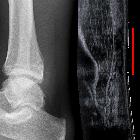retrocalcaneal bursitis






Retrocalcaneal bursitis refers to inflammation of the retrocalcaneal bursa, which lies between the anteroinferior calcaneal tendon and posterosuperior calcaneus. It forms part of Haglund syndrome.
Please, note that two bursae lie near the calcaneal tendon insertion: the retrocalcaneal bursa (between the tendon insertion and the posterior angle of the calcaneus) and the subcutaneous calcaneal bursa (between the tendon and the skin).
Clinical presentation
Patients present with posterior ankle pain made worse by passive dorsiflexion of the ankle with swelling/erythema in the region of the distal calcaneal tendon .
Pathology
Retrocalcaneal bursitis rarely occurs in isolation and is almost always associated with calcaneal tendinitis and/or Haglund deformity. The bursa may also be primarily involved by inflammatory or infectious bursitis .
Etiology
Causes include :
- calcaneal tendon injury: rupture or tendinitis
- inflammatory arthropathies: Reiter syndrome, ankylosing spondylitis, rheumatoid arthritis
- calcaneal fractures
- infectious bursitis
Radiographic features
Plain radiograph
- prominence of the posterosuperior calcaneum is frequently seen
- decreased lucency of the retrocalcaneal soft tissue (Kager triangle)
Ultrasound
- bursa distension by a hypoechoic fluid collection: >1 mm anteroposteriorly, >7 mm craniocaudally, or >11 mm transversely is considered abnormal
MRI
Bursa distension by a fluid collection:
- T1: low signal
- T2: high signal
- STIR: high signal
Treatment and prognosis
Most patients respond to conservative treatment (e.g. NSAIDs, heel lifts, CAM boot); steroid injections may also be of benefit but may cause tendinous rupture. Surgical treatment (excision of the bursa) is typically reserved for refractory cases.
See also
Siehe auch:
und weiter:

 Assoziationen und Differentialdiagnosen zu Bursitis subachilleae:
Assoziationen und Differentialdiagnosen zu Bursitis subachilleae:

